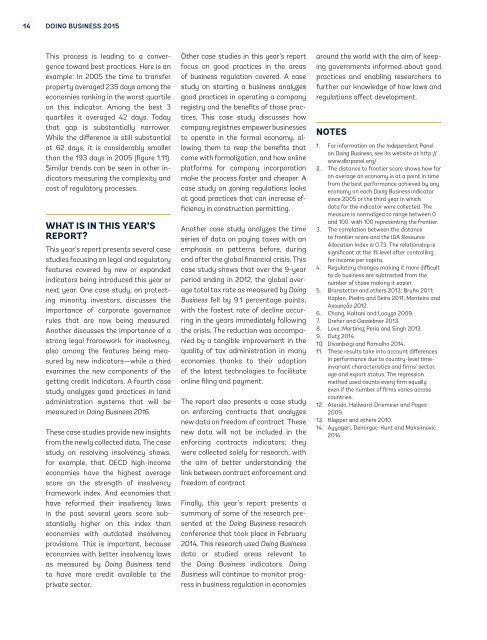bc8G2-7
bc8G2-7
bc8G2-7
Create successful ePaper yourself
Turn your PDF publications into a flip-book with our unique Google optimized e-Paper software.
14<br />
DOING BUSINESS 2015<br />
This process is leading to a convergence<br />
toward best practices. Here is an<br />
example: In 2005 the time to transfer<br />
property averaged 235 days among the<br />
economies ranking in the worst quartile<br />
on this indicator. Among the best 3<br />
quartiles it averaged 42 days. Today<br />
that gap is substantially narrower.<br />
While the difference is still substantial<br />
at 62 days, it is considerably smaller<br />
than the 193 days in 2005 (figure 1.11).<br />
Similar trends can be seen in other indicators<br />
measuring the complexity and<br />
cost of regulatory processes.<br />
WHAT IS IN THIS YEAR’S<br />
REPORT?<br />
This year’s report presents several case<br />
studies focusing on legal and regulatory<br />
features covered by new or expanded<br />
indicators being introduced this year or<br />
next year. One case study, on protecting<br />
minority investors, discusses the<br />
importance of corporate governance<br />
rules that are now being measured.<br />
Another discusses the importance of a<br />
strong legal framework for insolvency,<br />
also among the features being measured<br />
by new indicators—while a third<br />
examines the new components of the<br />
getting credit indicators. A fourth case<br />
study analyzes good practices in land<br />
administration systems that will be<br />
measured in Doing Business 2016.<br />
These case studies provide new insights<br />
from the newly collected data. The case<br />
study on resolving insolvency shows,<br />
for example, that OECD high-income<br />
economies have the highest average<br />
score on the strength of insolvency<br />
framework index. And economies that<br />
have reformed their insolvency laws<br />
in the past several years score substantially<br />
higher on this index than<br />
economies with outdated insolvency<br />
provisions. This is important, because<br />
economies with better insolvency laws<br />
as measured by Doing Business tend<br />
to have more credit available to the<br />
private sector.<br />
Other case studies in this year’s report<br />
focus on good practices in the areas<br />
of business regulation covered. A case<br />
study on starting a business analyzes<br />
good practices in operating a company<br />
registry and the benefits of those practices.<br />
This case study discusses how<br />
company registries empower businesses<br />
to operate in the formal economy, allowing<br />
them to reap the benefits that<br />
come with formalization, and how online<br />
platforms for company incorporation<br />
make the process faster and cheaper. A<br />
case study on zoning regulations looks<br />
at good practices that can increase efficiency<br />
in construction permitting.<br />
Another case study analyzes the time<br />
series of data on paying taxes with an<br />
emphasis on patterns before, during<br />
and after the global financial crisis. This<br />
case study shows that over the 9-year<br />
period ending in 2012, the global average<br />
total tax rate as measured by Doing<br />
Business fell by 9.1 percentage points,<br />
with the fastest rate of decline occurring<br />
in the years immediately following<br />
the crisis. The reduction was accompanied<br />
by a tangible improvement in the<br />
quality of tax administration in many<br />
economies thanks to their adoption<br />
of the latest technologies to facilitate<br />
online filing and payment.<br />
The report also presents a case study<br />
on enforcing contracts that analyzes<br />
new data on freedom of contract. These<br />
new data will not be included in the<br />
enforcing contracts indicators; they<br />
were collected solely for research, with<br />
the aim of better understanding the<br />
link between contract enforcement and<br />
freedom of contract.<br />
Finally, this year’s report presents a<br />
summary of some of the research presented<br />
at the Doing Business research<br />
conference that took place in February<br />
2014. This research used Doing Business<br />
data or studied areas relevant to<br />
the Doing Business indicators. Doing<br />
Business will continue to monitor progress<br />
in business regulation in economies<br />
around the world with the aim of keeping<br />
governments informed about good<br />
practices and enabling researchers to<br />
further our knowledge of how laws and<br />
regulations affect development.<br />
NOTES<br />
1. For information on the Independent Panel<br />
on Doing Business, see its website at http://<br />
www.dbrpanel.org/.<br />
2. The distance to frontier score shows how far<br />
on average an economy is at a point in time<br />
from the best performance achieved by any<br />
economy on each Doing Business indicator<br />
since 2005 or the third year in which<br />
data for the indicator were collected. The<br />
measure is normalized to range between 0<br />
and 100, with 100 representing the frontier.<br />
3. The correlation between the distance<br />
to frontier score and the IDA Resource<br />
Allocation Index is 0.73. The relationship is<br />
significant at the 1% level after controlling<br />
for income per capita.<br />
4. Regulatory changes making it more difficult<br />
to do business are subtracted from the<br />
number of those making it easier.<br />
5. Branstetter and others 2013; Bruhn 2011;<br />
Kaplan, Piedra and Seira 2011; Monteiro and<br />
Assunção 2012.<br />
6. Chang, Kaltani and Loayza 2009.<br />
7. Dreher and Gassebner 2013.<br />
8. Love, Martínez Pería and Singh 2013.<br />
9. Dutz 2014.<br />
10. Divanbeigi and Ramalho 2014.<br />
11. These results take into account differences<br />
in performance due to country-level timeinvariant<br />
characteristics and firms’ sector,<br />
age and export status. The regression<br />
method used counts every firm equally<br />
even if the number of firms varies across<br />
countries.<br />
12. Aterido, Hallward-Driemeier and Pages<br />
2009.<br />
13. Klapper and others 2010.<br />
14. Ayyagari, Demirguc-Kunt and Maksimovic<br />
2014.


